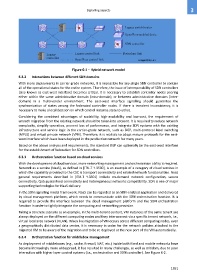Page 1361 - 5G Basics - Core Network Aspects
P. 1361
Signalling aspects 3
Legacy switch/router
OpenFlow-enabled devices
SDN controller
Legacy Legacy control link Data plane link
controller
OpenFlow control link Q Suppl.67(15)_F6-1
Figure 6-1 – Hybrid network model
6.3.2 Interactions between different SDN domains
With more deployments in carrier-grade networks, it is impossible for any single SDN controller to contain
all of the operational states for the entire system. Therefore, the issue of interoperability of SDN controllers
(also known as east-west interface) becomes critical. It is necessary to establish controller nodes peering
either within the same administrative domain (intra-domain), or between administrative domains (inter-
domain) in a multi-vender environment. The east-west interface signalling should guarantee the
synchronization of states among the federated controller nodes. If there is transient inconsistency, it is
necessary to make a local decision on which control instance state to utilize.
Considering the combined advantages of scalability, high-availability and low-cost, the requirement of
smooth migration from the existing network should be taken into account. It is required to reduce network
complexity, simplify operation, prevent loss of performance, and integrate SDN systems with the existing
infrastructure and service logic in the carrier-grade network, such as BGP, multi-protocol label switching
(MPLS) and virtual private network (VPN). Therefore, it is realistic to adopt mature protocols for the east-
west interface which have been deployed in the production network for many years.
Based on the above analysis and requirements, the standard BGP can optionally be the east-west interface
for the establishment of federation for SDN controllers.
6.3.3 Orchestration function based on cloud services
With the development of cloud services, more networking management and orchestration ability is required.
Network as a service (NaaS), as defined in [ITU-T Y.3500], is an example of a category of cloud services in
which the capability provided to the CSC is transport connectivity and related network functionalities. NaaS
general requirements described in [ITU-T Y.3501] include on-demand network configuration, secure
connectivity, QoS-guaranteed connectivity and heterogeneous networks compatibility. SDN is one of major
supporting technologies for NaaS delivery.
In the SDN signalling model framework, NaaS can be regarded as an SDN-enabled application and delivered
by cloud management platform, which needs to communicate with the SDN orchestration function. It is
required to provide the interface between the cloud management platform and the SDN orchestration
function in order to tightly integrate the computing and networking provision.
Taking a concrete scenario as an example, in the multi-tenant context, VM instances of the same tenant are
always deployed on the different computing nodes and they interconnect via a specific tenant network, i.e.,
virtual local area network (VLAN). When live migration of VM occurs across different computing nodes, even
a geographically distributed data center, it is necessary in order for the network policies attached to the
migrated VM to be aware of the migration and to be re-deployed at the new port of the VM automatically.
6.3.4 Orchestration function for middlebox management
As deployment of middleboxes (e.g., cache, firewall, NAT, etc.) inside both fixed and mobile networks have
become increasingly more widespread, it has resulted in many challenges, as well as criticism, due to poor
interaction with higher layer control systems (i.e., orchestration and SDN controller). See Figure 6-2.
1351

